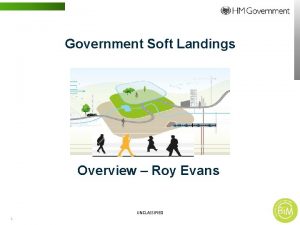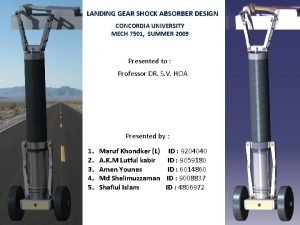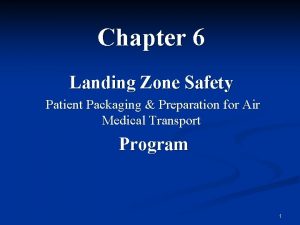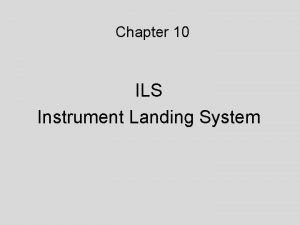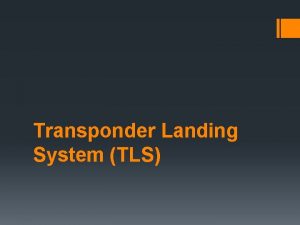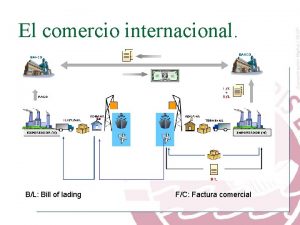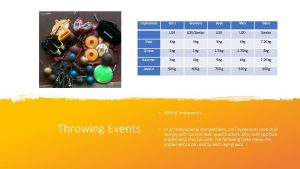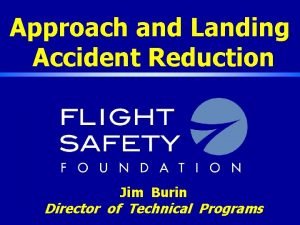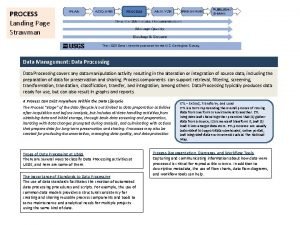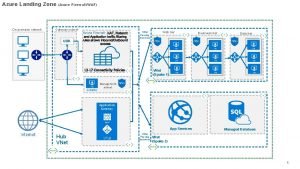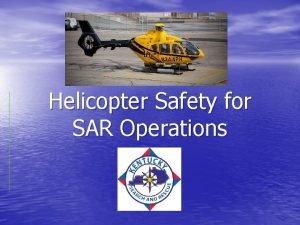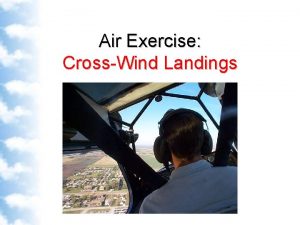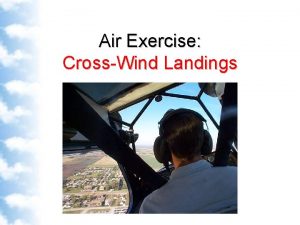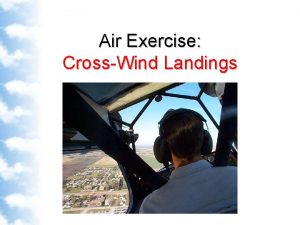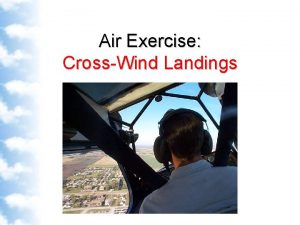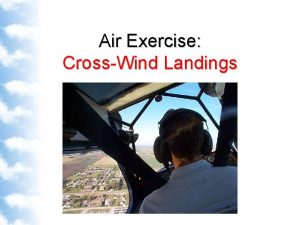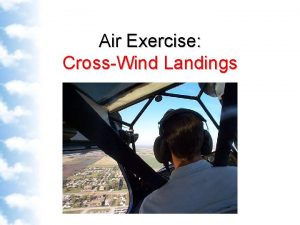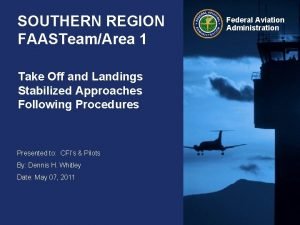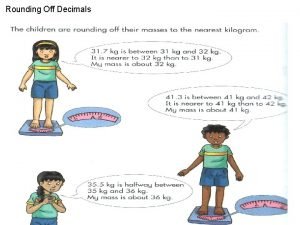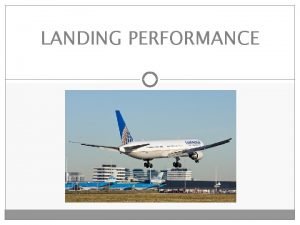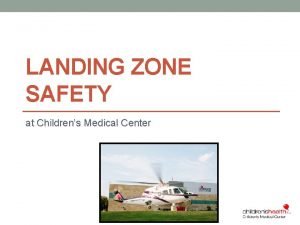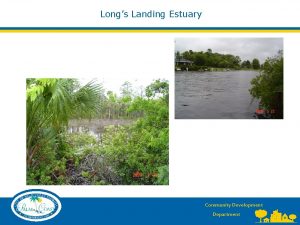Landing Out Landing Out Off Field Landings Outlandings






































- Slides: 38

Landing Out


Landing Out • • Off Field Landings Outlandings Off Airport Landings Landing at another Airport

Where can Land Outs Occur? • • Another airport Farmer’s field Lawn next to a girl’s school Road Lake Trees Island in a river

Landing Out • Landing somewhere other than where you started • Landing somewhere other than where you planned to land before the start of the flight

If you fly cross country, sooner or later, you will land out! • The results of your first few land outs will have a profound effect on your future in soaring • Failure – painful and discouraging • Success – while disappointing, can be encouraging • Preparation and practice WILL have a profound effect on your chances of success • Trial and Error approach not recommended

A Test Will Follow This Presentation • Your first (or next) off field landing!

Major Hazards • • Wires Slopes Fences Wires

Other Hazards • • • Rough terrain Ditches, roads Field too small Wind Difficult Approach Narrow Runway

Key Skills Required • Situational Awareness – Landing Options (varies with altitude) – Field Selection • • Precision Landings Airspeed Control Spin Proficiency Situational Awareness – Thinking ahead

Field Selection • Altitude High – General landable terrain awareness – Airports in GPS Database

Field Selection • Low Altitude – Airport – Wires – Wind/Slope – Field Size – Surface/crops – Approach – Ease of retrieve (least important)

Field Selection • Wires (invisible from above!) – Between two poles – Between a pole and trees – Between a road and a house – Above or along any road – Going to any kind of building – Anywhere crossing a narrow field

Field Selection • Sloped Field – Always land up hill, regardless of wind – Slope only visible when viewed from 90 degrees to landing direction – Landing up hill, carry extra speed, close spoilers in flare – Turn 90 degrees at end of rollout so glider won’t roll backwards down the hill – Landing across a slope not recommended


Field Selection • Wind Direction – GPS, smoke, lake surface, cloud shadows, waves in tall grass or crops – Parallel to narrow valley between two ridges – If you are not sure, probably doesn’t matter • Always land into the wind (unless) – Light winds, difficult approach down wind end – Sloped field

Field Selection • Surface/Crops – Freshly mowed hayfield best (no hay bales) – Low crops (alfalfa) OK – Freshly cultivated fields OK, but ground roll will be short. Look out for rocks. – Avoid plowed fields if possible – Avoid high crops, especially corn (if only option, flare and touch down at top of crop. – Avoid pastures (rocks, animals) – Discontinuities, wet areas


Field Selection • Do not rely on small private airports you have not personally inspected or someone you trust has not recommended • Assumption: GPS says there is an airport you can reach at 500 feet agl. • Reality: – – Airport closed Runway too narrow Owner hasn’t mowed the field all year GPS says it’s there, but I can’t find it!

Outlanding Procedure • • • Select several options by 2000 feet agl, radio off Select best field by 1200 feet agl Gear down, Fly full pattern at correct airspeed Use downwind to inspect field for rocks, holes, ditches, etc. • Plan to touch down well into field • If too high, use reverse pattern (never 360)


Outlanding Procedure • NEVER change your mind once committed to the pattern • If winds greater than 15 kts, expect turbulence • Touch down with minimum energy • But, watch out for wind shear • Stop as quickly as possible

Outlanding Procedure • Be flexible – Short field? Land on diagonal – Rolling surface? If possible land on a crest – High trees on approach, but not for the adjacent field, which is unsuitable for landing? Fly around the trees and then line up for your chosen field on a diagonal.

After Landing • Move glider clear so others can land • Relations with landowner – – If possible, contact landowner Apologies, thanks No matter what, be polite Don’t be too quick to offer payment for crop damage, but be agreeable to a reasonable payment • Dealing with the curious public – Don’t let them cause further crop damage • Retrieve – Write down lat/long and clear retrieve directions before calling retrieve office!

Preparation at Home Gliderport • Precision Landings (touchdown point and stopping point) • Minimum energy touchdowns • Landing without reference to altimeter (cover it up) • Varied IP altitudes • Get experience with different wind conditions

Preparation when not flying • While driving, look at fields, wires, crops, approaches, etc.

Staying in range of landable fields • Use of GPS & glide computer • “Airport hopping” • Just because an airport is in the database….

Examine your assumptions • • Database is current You’ll be able to spot airfield Airfield will be usable You will arrive high enough for a full pattern

“Flatland” Outlandings • You can evaluate a field from the air • The field that protects you is in view • Getting to it is simple & obvious

“Mountain” Outlandings • • You must know the individual field Scouting may be necessary Field may not be visible until nearby Path to the field may not be direct or obvious

Problem areas • • • Pastures Roads Parks & recreational fields Golf courses Parking lots

“Crashable” areas • Trees • Water • Sagebrush

“Don’t Do It” areas • • • Gravel pit Graveyard Orchard Grape Vineyard Inhabited area

Minimum safe field size – it depends • • Approaches, obstacles Altitude Wind Glider Surface Pilot’s skill & precision Ground loop, if necessary (stick forward)

Evaluating size • • Narrow looks long – long looks narrow Wide looks short – short looks wide Must have some idea about local fields Relative size of trees, power poles, buildings, etc.

Low Saves • • Don’t believe all the stories about 200 foot saves Radio off Don’t circle unless you can afford to lose 200 feet Low thermaling: coordinated turns plus 5 -10 kts extra airspeed Steeper banks better than shallow Head out of the cockpit Wait for a thermal on a ridge with good field in reach Low experience, currency? Give it up at 800 feet

Survival issues • • Mobile phone ELT use Radio (121. 5 MHz) Survival kit

Summary • Landouts are more risky than landing at the home airport, but with planning and preparation, they need not be excessively so • Prepare, practice, plan, discipline • Getting home always beats almost winning the day, but landing five miles short.
 Government soft landings
Government soft landings Safe dance practice
Safe dance practice Elbows off the table fingers off the food song
Elbows off the table fingers off the food song You're my kryptonite metaphor
You're my kryptonite metaphor Distinguish between magnetic and nonmagnetic materials
Distinguish between magnetic and nonmagnetic materials Difference between electric field and magnetic field
Difference between electric field and magnetic field Gauss law of magnetism
Gauss law of magnetism E field h field
E field h field Field dependent vs field independent
Field dependent vs field independent Data types and field properties
Data types and field properties Field dependent vs field independent
Field dependent vs field independent Field dependent definition
Field dependent definition Get into get out of
Get into get out of Vor aerodrome checkpoint marking
Vor aerodrome checkpoint marking Instrument landing system localizer
Instrument landing system localizer Human landing system
Human landing system Zdenka willis
Zdenka willis Landing gear shock absorber design
Landing gear shock absorber design Afpub
Afpub Sea transport solutions stern landing vessel
Sea transport solutions stern landing vessel Azure landing zone considerations
Azure landing zone considerations Inst154
Inst154 Treaty of paynes landing
Treaty of paynes landing Components of instrument landing system
Components of instrument landing system Transponder landing system
Transponder landing system Aircraft landing gear system
Aircraft landing gear system Bl bill
Bl bill Javelin landing sector
Javelin landing sector What do male ladybugs look like
What do male ladybugs look like Hvad er en landing page
Hvad er en landing page Marketo tokens
Marketo tokens Approach and landing accident reduction
Approach and landing accident reduction Hulls landing
Hulls landing Science fusion landing pages
Science fusion landing pages Azure zone region
Azure zone region A high arching shot landing near the baseline is called?
A high arching shot landing near the baseline is called? Christina landing apartments
Christina landing apartments Helicopter landing zone checklist
Helicopter landing zone checklist Wappetaw landing awendaw homes for sale
Wappetaw landing awendaw homes for sale
